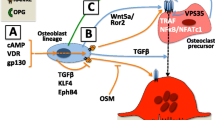Abstract
Osteoclasts (OCs) are the cells uniquely responsible for dissolving both the organic and inorganic components of bone during bone development and remodeling throughout life. These cells originate from hematopoietic precursors of the monocyte/macrophage lineage that are present both in the bone marrow and peripheral circulation, and their numbers and/or activity are frequently increased in a wide array of clinical disorders that are associated with excessive bone loss and affect millions of people (1). For many years, investigations into how OCs develop and function have been hampered by the considerable difficulties associated with isolating and culturing these normally rare cells. Whereas cell lines have frequently provided an invaluable research tool and are widely used to decipher mechanisms involved in osteoblast (OB) differentiation and bone formation, no immortalized cell lines for mature OCs exist and the few pre-OC cell lines that have been reported either do not undergo full OC differentiation (2,3) or involve coculture systems and cells that may not be readily available to all researchers (4–6). To compound the problem further, it has proven difficult or impossible until recently to generate reliably bone-resorptive OCs expressing mature OC characteristics from primary bone marrow or circulating precursor cells in vitro. However, recent breakthroughs have now made the latter possible owing to the identification of the key signal, receptor activator of nuclear factor κB ligand (RANKL), that is responsible for the full development and activation of OCs both in vitro and in vivo (7–9).
Access this chapter
Tax calculation will be finalised at checkout
Purchases are for personal use only
Similar content being viewed by others
References
Roodman, G. (1996) Advances in bone biology—the osteoclast. Endoc. Rev. 17, 308–332.
Mancini, L., Moradi-Bidhendi, N., Brandi, M., Perretti, M., and MacIntyre, I. (2000) Modulation of the effects of osteoprotegerin (OPG) ligand in a human leukemic cell line by OPG and calcitonin. Biochem. Biophys. Res. Commun. 279, 391–397.
Nagai, M., Kyakumoto, S., and Sato, N. (2000) Cancer cells responsible for humoral hypercalcemia express mRNA encoding a secreted form of ODF/TRANCE that induces osteoclast formation. Biochem. Biophys. Res. Commun. 269, 532–536.
Hentunen, T., Reddy, S., Boyce, B., et al. (1998) Immortalization of osteoclast precursors by targeting Bcl-XL and Simian virus 40 large T antigen to the osteoclast lineage in transgenic mice. J. Clin. Invest. 102, 88–97.
Chen, W. and Li, Y. (1998) Generation of mouse osteoclastogenic cell lines immortalized with SV40 large T antigen. J. Bone Miner. Res. 13, 1112–1123.
Takeshita, S., Kaji, K., and Kudo, A. (2000) Identification and characterization of the new osteoclast progenitor with macrophage phenotypes being able to differentiate into mature osteoclasts. J. Bone Miner. Res. 15, 1477–1488.
Takahashi, N., Udagawa, N., and Suda, T. (1999) A new member of tumor necrosis factor ligand family, ODF/OPGL/TRANCE/RANKL, regulates osteoclast differentiation and function. Biochem. Biophys. Res. Commun. 256, 449–455.
Chambers, T. (2000) Regulation of the differentiation and function of osteoclasts. J. Pathol. 192, 4–13.
Schoppet, M., Preissner, K., and Hofbauer, L. (2002) RANK ligand and osteoprotegerin. Paracrine regulators of bone metabolism and vascular function. Arterioscler. Thromb. Vasc. Biol. 22, 549–553.
Hsu, H., Lacey, D., Dunstan, C., et al. (1999) Tumor necrosis factor receptor family member RANK mediates osteoclast differentiation and activation induced by osteoprotegerin ligand. Proc. Natl. Acad. Sci. USA 96, 3540–3545.
Yamamoto, A., Miyazaki, T., Kadono, Y., et al. (2002) Possible involvement of IkappaB kinase 2 and MKK7 in osteoclastogenesis induced by receptor activator of nuclear factor kappaB ligand. J. Bone Miner. Res. 17, 612–621.
Mizukami, J., Takaesu, G., Akatsuka, H., et al. (2002) Receptor activator of NF-kappaB ligand (RANKL) activates TAK1 mitogen-activated protein kinase kinase through a signaling complex containing RANK, TAB2, and TRAF6. Mol. Cell. Biol. 22, 992–1000.
Raschke, W., Baird, S., Ralph, P., and Nakoinz, I. (1978) Functional macrophage cell lines transformed by Abelson leukemia virus. Cell 15, 261–267.
Shadduck, R., Waheed, A., Mangan, K., and Rosenfeld, C. (1993) Preparation of a monoclonal antibody directed against the receptor for murine colony-stimulating factor-1. Exp. Hematol. 21, 515–520.
Koseki, T., Gao, Y., Okahashi, N., et al. (2002) Role of TGF-beta family in osteoclastogenesis induced by RANKL. Cell Signal 14, 31–36.
Shin, J., Kim, I., Lee, J., Koh, G., Lee, Z., and Kim, H. (2002) A novel zinc finger protein that inhibits osteoclastogenesis and the function of tumor necrosis factor receptor-associated factor 6. J. Biol. Chem. 277, 8346–8353.
Sells-Galvin, R., Cullison, J., Avioli, L., and Osdoby, P. (1994) Influence of osteoclasts and osteoclast-like cells on osteoblast alkaline phosphatase activity and collagen synthesis. J. Bone Miner. Res. 9, 1167–1178.
Yu, X., Collin-Osdoby, P., and Osdoby, P. (2003) SDF-1 increases recruitment of osteoclast precursors by upregulation of matrix metalloproteinase-9 activity. Connect. Tissue Res. 44(Suppl. 1), 1–6.
Cappellen, D., Luong-Nguyen, N., Bongiovanni, S., Grenet, O., Wanke, C., and Susa, M. (2002) Transcriptional program of mouse osteoclast differentiation governed by the macrophage colony-stimulating factor and the ligand for the receptor activator of NF-kappa B. J. Biol. Chem. 277, 21,971–21,982.
Author information
Authors and Affiliations
Editor information
Editors and Affiliations
Rights and permissions
Copyright information
© 2003 Humana Press Inc., Totowa, NJ
About this protocol
Cite this protocol
Collin-Osdoby, P., Yu, X., Zheng, H., Osdoby, P. (2003). RANKL-Mediated Osteoclast Formation from Murine RAW 264.7 Cells. In: Helfrich, M.H., Ralston, S.H. (eds) Bone Research Protocols. Methods in Molecular Medicine, vol 80. Humana Press. https://doi.org/10.1385/1-59259-366-6:153
Download citation
DOI: https://doi.org/10.1385/1-59259-366-6:153
Publisher Name: Humana Press
Print ISBN: 978-1-58829-044-1
Online ISBN: 978-1-59259-366-8
eBook Packages: Springer Protocols




